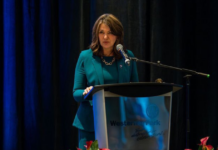As the city ushers in the spring season under persistent drought conditions, Calgary officials are hinting at the imminent need for water conservation orders for the second consecutive year.
The potential of outdoor water restrictions as early as May comes in response to a forecast predicting warmer than usual temperatures, raising alarms over the city’s water supply sustainability.
Mayor Jyoti Gondek said Calgarians have reduced water consumption over the last 20 years. She said that the city is taking less water from the river than it did in 2003, with a population that has increased by half a million.
“It’s critical that we work together to do our part and incorporate water conservation into our daily routines this year,” she said. “It’s in Calgarians’ nature to answer the call when an emergent situation arises, and I know this year will be no different.”
The city will make its contribution towards conserving water this spring. The city said in a news release that its vehicles will be less “sparkly clean,” that park spaces will be less green, and display fountains will operate less frequently “to make every drop count.”
When outdoor water use is required, Calgary will be more prudent about how it is used. The city plans to reuse stormwater to water golf courses, park spaces, and flower baskets and use an efficient irrigation system, which uses 30% less water to keep sporting turfs in good condition.
This April, Calgary will begin acampaign called “Together We Can Make Every Drop Count,” which aims to will provide Calgarians with ways to conserve and consume water more judiciously.
“Not only will these actions save water, but it will also help them save money on their water bills,” said the city’s press release.
Calgary also recommended that its citizens begin taking short showers, washing only full loads of dishes and laundry in their respective machines, and turning off the tap when brushing their teeth or shaving. The city said this can help save the average household hundreds of litres of water per month and “collectively more than three million litres.”
The city also advocated for installing rain barrels and using mulch in gardens to reduce water evaporation.
Nicole Newton, Manager of Natural Environment and Adaptation, said the forecast predicts warmer-than-average temperatures this spring. She noted that warmer weather could increase pressure on the city’s water supply if citizens are not mindful of their water use.
“If dry conditions persist, outdoor water restrictions may be in place as early as May 1 to ensure there is enough water to meet Calgary’s essential needs, including water for drinking and fighting fires, as well as to support our neighbours and river health,” she said.
In an op-ed previously published on True North, Alberta’s Environment Minister Rebecca Schulz echoed the concerns of warmth. She said that the last three years brought droughts and water shortages to various areas in the province, particularly southern Alberta, last summer.
She added that the world was experiencing El Niño, a global phenomenon causing less snow and rain, accompanied by higher temperatures. She said that forecasts indicated a 62% chance that this would continue until June 2024.
The province has five stages in its water management plan. The plan ranges from Stage 1, a minor drought, to Stage 5, a province-wide emergency. At Schulz’s time of publication in December, the province was at Stage 4. Alberta remains in Stage 4.
Schulz warned that Albertans would have to come together to secure the province’s water supply.
Calgary has its own management plan based on current drought conditions. The range spans from normal, to dry, very dry, and extremely dry. During the very dry and extremely dry ranges, there are four stages of mandatory water restrictions.
Each stage has a variety of restrictions. Violating the restrictions can result in a fine ranging from $400 at Stage 1 to $3,000 at Stage 4.
Alberta previously announced up to $165 million in federal-provincial drought relief for livestock producers. Calgary, Medicine Hat, and other communities implemented voluntary and mandatory restrictions on water to assist Alberta’s strained river basins.
City officials will continue to oversee watershed conditions, including snowpack levels, river currents, reservoir volumes, upcoming forecasts, anticipated water usage, and other relevant factors to guide Calgary’s necessary response.
Calgary will provide an update on drought conditions and its expected response in late April.





















